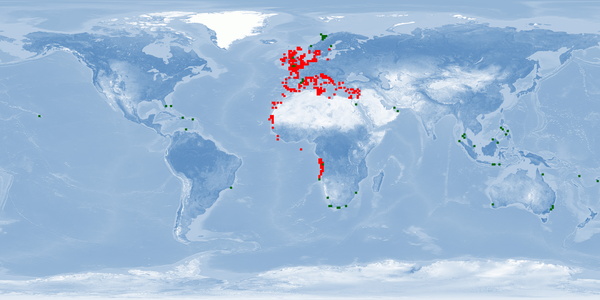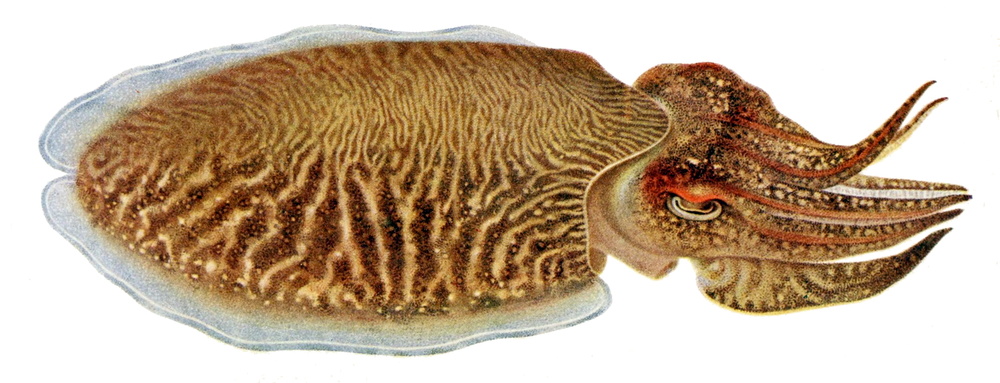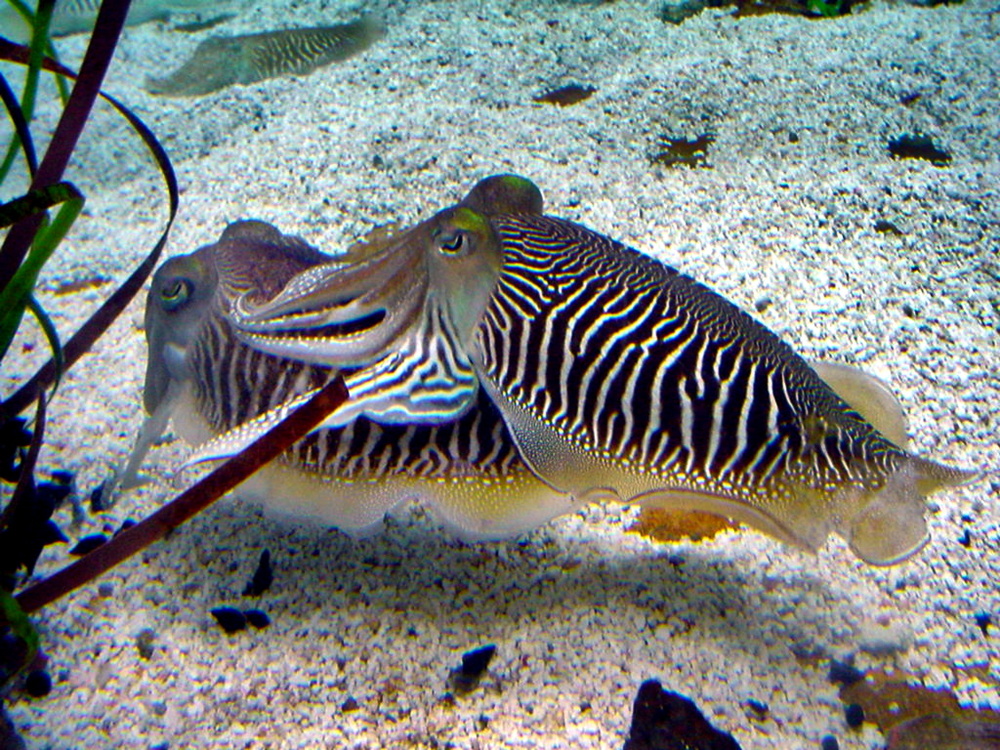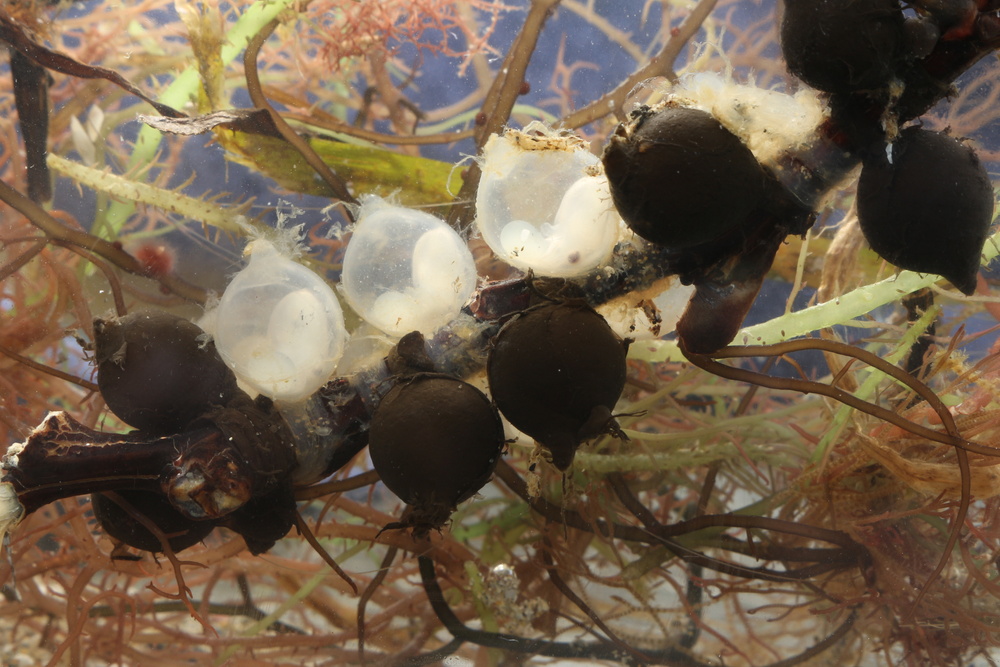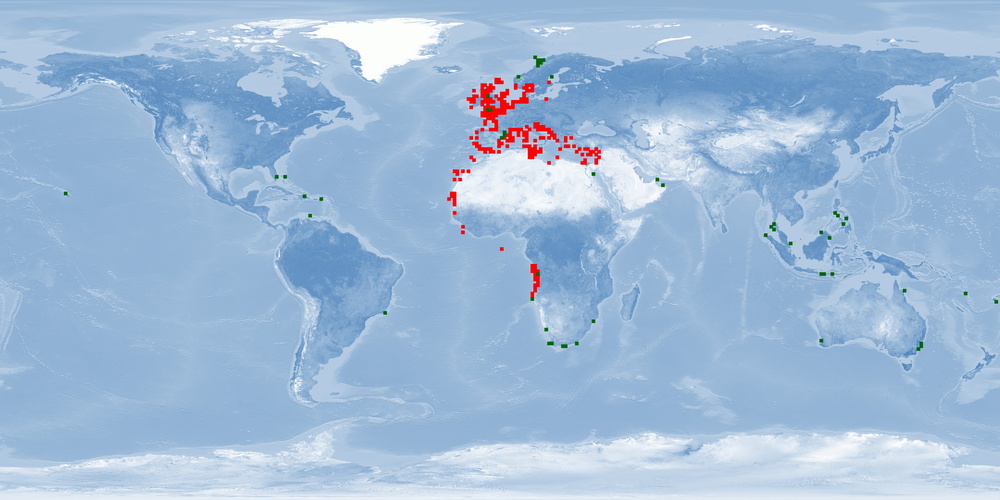Information
Version: B | 1.1 (2022-02-24)
WelfareScore | farm
Condensed assessment of the species' likelihood and potential for good fish welfare in aquaculture, based on ethological findings for 10 crucial criteria.
- Li = Likelihood that the individuals of the species experience good welfare under minimal farming conditions
- Po = Potential of the individuals of the species to experience good welfare under high-standard farming conditions
- Ce = Certainty of our findings in Likelihood and Potential
WelfareScore = Sum of criteria scoring "High" (max. 10)
General remarks
Sepia officinalis is mostly found in the eastern Atlantic and in the Mediterranean Sea, attaining interest for fisheries and high market value; and it is used as an animal model for biological and biomedical research, for aquaculture production, and also for public exhibition in aquariums. However, the main bottlenecks in the S. officinalis culture are reproduction, feeding, and nutrition, which need to be solved before applying them to an industrial scale for human consumption. Though it is already cultured for the complete life cycle in consecutively bred generations, wild individuals (eggs) are still being introduced to improve genetic pools. Detrimental for welfare in captivity are the seasonal migrations (mainly vertical) S. officinalis undertakes in the wild and that the current farming techniques result in high stress due to high densities, aggregations, and food and mate competitions, which consequently increase aggression at different life stages. In addition, cuttlefish skin is particularly sensitive and can be easily damaged during handling, transportation or stressful conditions due to confinement, and a humane slaughtering protocol is not yet established.
1 Home range
Many species traverse in a limited horizontal space (even if just for a certain period of time per year); the home range may be described as a species' understanding of its environment (i.e., its cognitive map) for the most important resources it needs access to.
What is the probability of providing the species' whole home range in captivity?
It is low for minimal and high-standard farming conditions. Our conclusion is based on a medium amount of evidence.


2 Depth range
Given the availability of resources (food, shelter) or the need to avoid predators, species spend their time within a certain depth range.
What is the probability of providing the species' whole depth range in captivity?
It is low for minimal and high-standard farming conditions. Our conclusion is based on a high amount of evidence.


3 Migration
Some species undergo seasonal changes of environments for different purposes (feeding, spawning, etc.), and to move there, they migrate for more or less extensive distances.
What is the probability of providing farming conditions that are compatible with the migrating or habitat-changing behaviour of the species?
It is low for minimal and high-standard farming conditions. Our conclusion is based on a high amount of evidence.


4 Reproduction
A species reproduces at a certain age, season, and sex ratio and possibly involving courtship rituals.
What is the probability of the species reproducing naturally in captivity without manipulation of theses circumstances?
It is low for minimal farming conditions. It is high for high-standard farming conditions. Our conclusion is based on a high amount of evidence.


5 Aggregation
Species differ in the way they co-exist with conspecifics or other species from being solitary to aggregating unstructured, casually roaming in shoals or closely coordinating in schools of varying densities.
What is the probability of providing farming conditions that are compatible with the aggregation behaviour of the species?
It is low for minimal and high-standard farming conditions. Our conclusion is based on a medium amount of evidence.


6 Aggression
There is a range of adverse reactions in species, spanning from being relatively indifferent towards others to defending valuable resources (e.g., food, territory, mates) to actively attacking opponents.
What is the probability of the species being non-aggressive and non-territorial in captivity?
It is low for minimal farming conditions. It is medium for high-standard farming conditions. Our conclusion is based on a medium amount of evidence.


7 Substrate
Depending on where in the water column the species lives, it differs in interacting with or relying on various substrates for feeding or covering purposes (e.g., plants, rocks and stones, sand and mud, turbidity).
What is the probability of providing the species' substrate and shelter needs in captivity?
It is low for minimal farming conditions. It is high for high-standard farming conditions. Our conclusion is based on a medium amount of evidence.


8 Stress
Farming involves subjecting the species to diverse procedures (e.g., handling, air exposure, short-term confinement, short-term crowding, transport), sudden parameter changes or repeated disturbances (e.g., husbandry, size-grading).
What is the probability of the species not being stressed?
It is low for minimal farming conditions. It is medium for high-standard farming conditions. Our conclusion is based on a high amount of evidence.


9 Malformations
Deformities that – in contrast to diseases – are commonly irreversible may indicate sub-optimal rearing conditions (e.g., mechanical stress during hatching and rearing, environmental factors unless mentioned in crit. 3, aquatic pollutants, nutritional deficiencies) or a general incompatibility of the species with being farmed.
What is the probability of the species being malformed rarely?
It is unclear for minimal and high-standard farming conditions. Our conclusion is based on a low amount of evidence.


10 Slaughter
The cornerstone for a humane treatment is that slaughter a) immediately follows stunning (i.e., while the individual is unconscious), b) happens according to a clear and reproducible set of instructions verified under farming conditions, and c) avoids pain, suffering, and distress.
What is the probability of the species being slaughtered according to a humane slaughter protocol?
It is low for minimal farming conditions. It is medium for high-standard farming conditions. Our conclusion is based on a medium amount of evidence.


Side note: Domestication
Teletchea and Fontaine introduced 5 domestication levels illustrating how far species are from having their life cycle closed in captivity without wild input, how long they have been reared in captivity, and whether breeding programmes are in place.
What is the species’ domestication level?
DOMESTICATION LEVEL 4 49, level 5 being fully domesticated.
Side note: Forage fish in the feed
450-1,000 milliard wild-caught fishes end up being processed into fish meal and fish oil each year which contributes to overfishing and represents enormous suffering. There is a broad range of feeding types within species reared in captivity.
To what degree may fish meal and fish oil based on forage fish be replaced by non-forage fishery components (e.g., poultry blood meal) or sustainable sources (e.g., soybean cake)?
All age classes: WILD: carnivorous; prey on crustaceans, fishes, molluscs, polychaetes, and nemertean worms 6. FARM: live shrimps or frozen diets based on crustaceans or a mixture of crustaceans and fishes 7. Unsuccessful attempts of partly* replacing fish meal and fish oil with pelleted diets 51 52 53 54.
*partly = <51% – mostly = 51-99% – completely = 100%
Glossary
BENTHIC = living at the bottom of a body of water, able to rest on the floor
DOMESTICATION LEVEL 4 = entire life cycle closed in captivity without wild inputs 50
FARM = setting in farming environment or under conditions simulating farming environment in terms of size of facility or number of individuals
IND = individuals
JUVENILES = fully developed but immature individuals, for details ➝ Findings 10.1 Ontogenetic development
LAB = setting in laboratory environment
LARVAE = hatching to mouth opening, for details ➝ Findings 10.1 Ontogenetic development
NEKTONIC = horizontal movement by active swimming
PHOTOPERIOD = duration of daylight
SPAWNERS = adults during the spawning season; in farms: adults that are kept as broodstock
WILD = setting in the wild
Bibliography
2 Guerra, Angel, Marcos Pérez-Losada, Francisco Rocha, and Andrés Sanjuan. 2001. Species differentiation of Sepia officinalis and Sepia hierredda (Cephalopoda: Sepiidae) based on morphological and allozyme analyses. Journal of the Marine Biological Association of the United Kingdom 81: 271–281. https://doi.org/10.1017/S0025315401003745.
3 Sykes, António V., Pedro M. Domingues, Maria Loyd, Anne Sommerfield, and José P. Andrade. 2003. The influence of culture density and enriched environments on the first stage culture of young cuttlefish, Sepia officinalis (Linnaeus, 1758). Aquaculture International 11: 531–544. https://doi.org/10.1023/B:AQUI.0000013262.15437.e4.
4 Abecasis, David, Pedro Afonso, Ron K. O’Dor, and Karim Erzini. 2013. Small MPAs do not protect cuttlefish (Sepia officinalis). Fisheries Research 147: 196–201. https://doi.org/10.1016/j.fishres.2013.05.004.
5 Forsythe, John, Phillip Lee, Leigh Walsh, and Tara Clark. 2002. The effects of crowding on growth of the European cuttlefish, Sepia officinalis Linnaeus, 1758 reared at two temperatures. Journal of Experimental Marine Biology and Ecology 269: 173–185. https://doi.org/10.1016/S0022-0981(02)00006-0.
6 Guerra, Ángel. 2006. Ecology of sepia offcinalis. Vie et Milieu 56: 97–107.
7 Sykes, António V., Pedro Domingues, and José Pedro Andrade. 2014. Sepia officinalis. In Cephalopod Culture, ed. José Iglesias, Lidia Fuentes, and Roger Villanueva, 175–204. Dordrecht: Springer Netherlands. https://doi.org/10.1007/978-94-017-8648-5_11.
8 Fiorito, Graziano, Andrea Affuso, Jennifer Basil, Alison Cole, Paolo de Girolamo, Livia D’Angelo, Ludovic Dickel, et al. 2015. Guidelines for the Care and Welfare of Cephalopods in Research –A consensus based on an initiative by CephRes, FELASA and the Boyd Group. Laboratory Animals 49: 1–90. https://doi.org/10.1177/0023677215580006.
9 Forsythe, J. W., R. H. DeRusha, and R. T. Hanlon. 1994. Growth, reproduction and life span of Sepia officinalis (Cephalopoda: Mollusca) cultured through seven consecutive generations. Journal of Zoology 233: 175–192. https://doi.org/10.1111/j.1469-7998.1994.tb08582.x.
10 Roper, Clyde F. E., Michael J. Sweeney, and C. E. Nauen. 1984. FAO species catalogue. Vol. 3. Cephalopods of The World An Annotated and Illustrated Catalogue of Species of Interest to Fisheries. Vol. 3. FAO Fisheries Synopsis 125. Rome, Italy: Food and Agriculture Organization of the United Nations.
11 Koueta, N, and E Boucaud-Camou. 2003. Combined effects of photoperiod and feeding frequency on survival and growth of juvenile cuttlefish Sepia officinalis L. in experimental rearing. Journal of Experimental Marine Biology and Ecology 296: 215–226. https://doi.org/10.1016/S0022-0981(03)00322-8.
12 Sykes, A V, P M Domingues, M Correia, and J P Andrade. 2006. Cuttlefish culture - state of the art and future trends: 10.
13 Sykes, António V, Diana Pereira, Covadonga Rodríguez, António Lorenzo, and José P Andrade. 2013. Effects of increased tank bottom areas on cuttlefish (Sepia officinalis, L.) reproduction performance. Aquaculture Research 44: 1017–1028. https://doi.org/10.1111/j.1365-2109.2012.03106.x.
14 Gauvrit, E., R. Le Goff, and J. Daguzan. 1997. Reproductive cycle of the cuttlefish, Sepia officinalis (L.) in the nothern part of the Bay of Biscay. Journal of Molluscan Studies 63: 19–28. https://doi.org/10.1093/mollus/63.1.19.
15 Wang, Jianjun, Graham J Pierce, Peter R Boyle, Vincent Denis, Jean-Paul Robin, and Jose M Bellido. 2003. Spatial and temporal patterns of cuttlefish (Sepia officinalis) abundance and environmental influences – a case study using trawl fishery data in French Atlantic coastal, English Channel, and adjacent waters. ICES Journal of Marine Science 60: 1149–1158. https://doi.org/10.1016/S1054-3139(03)00118-8.
16 Batista, Marisa I., Célia M. Teixeira, and Henrique N. Cabral. 2009. Catches of target species and bycatches of an artisanal fishery: The case study of a trammel net fishery in the Portuguese coast. Fisheries Research 100: 167–177. https://doi.org/10.1016/j.fishres.2009.07.007.
17 Neves, A., H. Cabral, V. Sequeira, I. Figueiredo, T. Moura, and L.S. Gordo. 2009. Distribution patterns and reproduction of the cuttlefish, Sepia officinalis in the Sado estuary (Portugal). Journal of the Marine Biological Association of the United Kingdom 89: 579–584. https://doi.org/10.1017/S0025315409002677.
18 Ezzeddine-Najai, Soufia. 1997. Tagging of the cuttlefish, Sepia officinalis L. (Cephalopoda: Decapoda), in the Gulf of Tunis: 8.
19 Bloor, Isobel S.M., Victoria J. Wearmouth, Stephen P. Cotterell, Matthew J. McHugh, Nicolas E. Humphries, Emma L. Jackson, Martin J. Attrill, and David W. Sims. 2013. Movements and behaviour of European common cuttlefish Sepia officinalis in English Channel inshore waters: First results from acoustic telemetry. Journal of Experimental Marine Biology and Ecology 448: 19–27. https://doi.org/10.1016/j.jembe.2013.06.013.
20 Keller, Stefanie, Maria Valls, Manuel Hidalgo, and Antoni Quetglas. 2014. Influence of environmental parameters on the life-history and population dynamics of cuttlefish Sepia officinalis in the western Mediterranean. Estuarine, Coastal and Shelf Science 145: 31–40. https://doi.org/10.1016/j.ecss.2014.04.016.
21 Guerra, Angel, and Bernardino G Castro. 1988. On the life cycle of Sepia officinalis (Cephalopoda, Sepioidea) in the ria de Vigo (NW Spain): 11.
22 Laptikhovsky, Vladimir, Alp Salman, Bahadir Önsoy, and Tuncer Katagan. 2003. Fecundity of the common cuttlefish, Sepia officinalis L. (Cephalopoda, Sepiida): a new look at the old problem. Scientia Marina 67: 279–284. https://doi.org/10.3989/scimar.2003.67n3279.
23 Dunn, M. R. 1999. Aspects of the stock dynamics and exploitation of cuttlefish, Sepia officinalis (Linnaeus, 1758), in the English Channel. Fisheries Research 40: 277–293. https://doi.org/10.1016/S0165-7836(98)00223-9.
24 Sykes, A.V., E. Almansa, A. Lorenzo, and J.P. Andrade. 2009. Lipid characterization of both wild and cultured eggs of cuttlefish (Sepia officinalis L.) throughout the embryonic development. Aquaculture Nutrition 15: 38–53. https://doi.org/10.1111/j.1365-2095.2008.00566.x.
25 Sykes, António V, Daniel Quintana, and José P Andrade. 2014. The Effects of light intensity on growth and survival of cuttlefish (sepia officinalis) hatchlings and Juveniles. Aquaculture Research 45: 2032–2040. https://doi.org/10.1111/are.12150.
26 Domingues, Pedro M., António Sykes, and José P. Andrade. 2001. The use of Artemia sp. or mysids as food source for hatchlings of the cuttlefish (Sepia officinalis L.); effects on growth and survival throughout the life cycle. Aquaculture International 9: 319–331. https://doi.org/10.1023/A:1020416811568.
27 Domingues, Pedro M., António Sykes, and José P. Andrade. 2002. The effects of temperature in the life cycle of two consecutive generations of the cuttlefish Sepia officinalis (Linnaeus, 1758), cultured in the Algarve (South Portugal). Aquaculture International 10: 207–220. https://doi.org/10.1023/A:1022148802078.
28 Domingues, P., R. Poirier, L. Dickel, E. Almansa, A. Sykes, and J.P. Andrade. 2003. Effects of culture density and live prey on growth and survival of juvenile cuttlefish, Sepia officinalis. Aquaculture International 11: 225–242. https://doi.org/10.1023/A:1024803802486.
29 Correia, Miguel, Pedro M. Domingues, António Sykes, and José P. Andrade. 2005. Effects of culture density on growth and broodstock management of the cuttlefish, Sepia officinalis (Linnaeus, 1758). Aquaculture 245: 163–173. https://doi.org/10.1016/j.aquaculture.2004.12.017.
30 Hanlon, R T, Ament, and Gabr. 1999. Behavioral aspects of sperm competition in cuttlefish, Sepia officinalis (Sepioidea: Cephalopoda): 10.
31 Warnke, K. 1994. Some aspects of social interaction during feeding in Sepia officinals (Mollusca: Cephalopoda) hatched and reared in the laboratory: 7.
32 Domingues, P., and L. Márquez. 2010. Effects of culture density and bottom area on growth and survival of the cuttlefish Sepia officinalis (Linnaeus, 1758). Aquaculture International 18: 361–369. https://doi.org/10.1007/s10499-009-9249-3.
33 Boal, Jean Geary, Rebecca A Hylton, Susan A Gonzalez, and Roger T Hanlon. 1999. Effects of Crowding on the Social Behavior of Cuttlefish (Sepia officinalis) 38: 7.
34 Domingues, P. M., T. Kingston, A. Sykes, and J. P. Andrade. 2001. Growth of young cuttlefish, Sepia officinalis (Linnaeus 1758) at the upper end of the biological distribution temperature range. Aquaculture Research 32: 923–930. https://doi.org/10.1046/j.1365-2109.2001.00631.x.
35 Bloor, Isobel S.M., Martin J. Attrill, and Emma L. Jackson. 2013. A Review of the Factors Influencing Spawning, Early Life Stage Survival and Recruitment Variability in the Common Cuttlefish (Sepia officinalis). In Advances in Marine Biology, 65:1–65. Elsevier. https://doi.org/10.1016/B978-0-12-410498-3.00001-X.
36 Abecasis, D, P Afonso, and K Erzini. 2014. Combining multispecies home range and distribution models aids assessment of MPA effectiveness. Marine Ecology Progress Series 513: 155–169. https://doi.org/10.3354/meps10987.
37 Sykes, António V., Filipa D. Baptista, Rui A. Gonçalves, and José P. Andrade. 2012. Directive 2010/63/EU on animal welfare: a review on the existing scientific knowledge and implications in cephalopod aquaculture research: Cephalopod aquaculture research welfare. Reviews in Aquaculture 4: 142–162. https://doi.org/10.1111/j.1753-5131.2012.01070.x.
38 Hanley, J.S., Nadav Shashar, R. Smolowitz, W. Mebane, and Hanlon, R T. 1999. Soft-sided Tanks Improve Long-term Health of Cultured Cuttlefish 197: 237–238.
39 King, Alison J., and Shelley A. Adamo. 2006. The ventilatory, cardiac and behavioural responses of resting cuttlefish (Sepia officinalis L.) to sudden visual stimuli. Journal of Experimental Biology 209: 1101–1111. https://doi.org/10.1242/jeb.02116.
40 Sobrino, I, L Silva, J M Bellido, and F Ramos. 2002. Rainfall, river discharges and sea temperature as factors affecting abundance of two coastal benthic cephalopod species in the Gulf of Cádiz (SW Spain). BULLETIN OF MARINE SCIENCE 71: 15.
41 Sykes, António V, Pedro M Domingues, Lorenzo Márquez, and José P Andrade. 2011. The effects of tank colours on the growth and survival of cuttlefish (Sepia officinalis, Linnaeus 1758) hatchlings and juveniles: Optimizing cuttlefish growth and survival through tank colours. Aquaculture Research 42: 441–449. https://doi.org/10.1111/j.1365-2109.2010.02639.x.
42 Gonçalves, Rui A., Cláudia Aragão, Paulo A. Frias, and António V. Sykes. 2012. The use of different anaesthetics as welfare promoters during short-term human manipulation of European cuttlefish (Sepia officinalis) juveniles. Aquaculture 370–371: 130–135. https://doi.org/10.1016/j.aquaculture.2012.10.014.
43 Gutowska, Magdalena A., Frank Melzner, Hans O. Pörtner, and Sebastian Meier. 2010. Cuttlebone calcification increases during exposure to elevated seawater pCO2 in the cephalopod Sepia officinalis. Marine Biology 157: 1653–1663. https://doi.org/10.1007/s00227-010-1438-0.
44 Boyer, Christophe, Eric Maubert, Yves Charnay, and Raymond Chichery. 2007. Distribution of neurokinin A-like and serotonin immunoreactivities within the vertical lobe complex in Sepia officinalis. Brain Research 1133: 53–66. https://doi.org/10.1016/j.brainres.2006.11.042.
45 Wollesen, T., R. Loesel, and A. Wanninger. 2009. Pygmy squids and giant brains: Mapping the complex cephalopod CNS by phalloidin staining of vibratome sections and whole-mount preparations. Journal of Neuroscience Methods 179: 63–67. https://doi.org/10.1016/j.jneumeth.2009.01.021.
46 Bardou, Isabelle, Jérôme Leprince, Raymond Chichery, Hubert Vaudry, and Véronique Agin. 2010. Vasopressin/oxytocin-related peptides influence long-term memory of a passive avoidance task in the cuttlefish, Sepia officinalis. Neurobiology of Learning and Memory 93: 240–247. https://doi.org/10.1016/j.nlm.2009.10.004.
47 Talbot, Christopher M., and Justin N. Marshall. 2011. The retinal topography of three species of coleoid cephalopod: significance for perception of polarized light. Philosophical Transactions of the Royal Society B: Biological Sciences 366: 724–733. https://doi.org/10.1098/rstb.2010.0254.
48 Andrews, Paul L. R., Anne-Sophie Darmaillacq, Ngaire Dennison, Ian G. Gleadall, Penny Hawkins, John B. Messenger, Daniel Osorio, Valerie J. Smith, and Jane A. Smith. 2013. The identification and management of pain, suffering and distress in cephalopods, including anaesthesia, analgesia and humane killing. Journal of Experimental Marine Biology and Ecology 447. Cephalopod Biology a Special Issue Compiled under the Auspices of No-Profit Research Organization CephRes: 46–64. https://doi.org/10.1016/j.jembe.2013.02.010.
49 Teletchea, Fabrice. 2015. Domestication of Marine Fish Species: Update and Perspectives. Journal of Marine Science and Engineering 3: 1227–1243. https://doi.org/10.3390/jmse3041227.
50 Teletchea, Fabrice, and Pascal Fontaine. 2012. Levels of domestication in fish: implications for the sustainable future of aquaculture. Fish and Fisheries 15: 181–195. https://doi.org/10.1111/faf.12006.
51 Lee, Phillip G, John W Forsythe, F Paul DiMarco, Randal H DeRusha, and Roger T Hanlon. 1991. Initial palatability and growth trials on pelleted diets for cephalopods. Bulletin of Marine Science 49: 362–372.
52 Castro, Bernardino G, and Phillip G Lee. 1994. The effects of semi-purified diets on growth and condition of Sepia oficinalis L. (Mollusca: Cephalopoda). Comp. Biochem. Physiol. 109A: 1007–1016.
53 Domingues, Pedro, Ana Ferreira, Lorenzo Marquez, José P. Andrade, Nelda López, and Carlos Rosas. 2008. Growth, absorption and assimilation efficiency by mature cuttlefish (Sepia officinalis) fed with alternative and artificial diets. Aquaculture International 16: 215–229. https://doi.org/10.1007/s10499-007-9139-5.
54 Ferreira, A., L. Marquez, E. Almansa, J.P. Andrade, A. Lorenzo, and P.M. Domingues. 2009. The use of alternative diets to culture juvenile cuttlefish, Sepia officinalis: effects on growth and lipid composition: Alternative diets and lipid composition in S. officinalis. Aquaculture Nutrition 16: 262–275. https://doi.org/10.1111/j.1365-2095.2009.00661.x.







